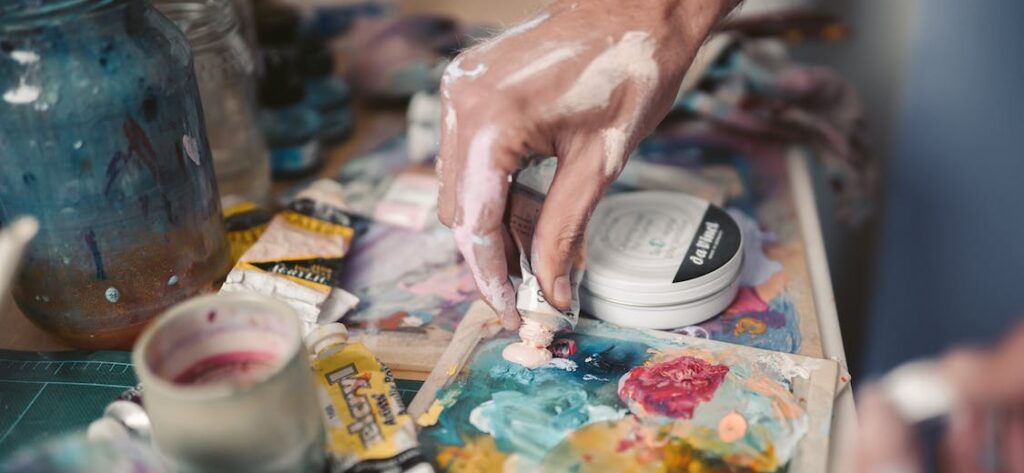The short answer is no. Freezing oil paints can cause them to become stiff, brittle, and difficult to work with.
As a result, it may be best to avoid freezing your oil paint products altogether if you want them to retain their quality.
Oil paints are made up of two components: oil and pigment. The oil acts as the binder for the pigment, helping it stick to the surface on which it’s applied.
When exposed to extreme temperatures, such as when frozen, the chemical composition of these elements can change drastically.
The low temperatures will also cause the oil particles to expand, which can make them crack or chip off from their binding agent – leading to discoloration, cracking, or flaking of the paint surface after thawing.
In addition, the freezing process can also affect the consistency of oil paints when they are used after thawing.
The paint may become thicker and stiffer due to the temperature change, making it difficult to apply or mix with other colors that were not frozen.
This can lead to an unpredictable painting experience, as well as possibly ruining your artwork!
Overall, if you want to ensure that your oil paints remain in their highest quality condition for longer, then it’s best to avoid freezing them.
Keeping them stored at a stable room temperature is generally recommended for optimal usage and performance.
However, if you have no choice but to freeze your paints, then be sure to allow them enough time to thaw before using them, as the thawing process will affect the consistency of your paints.
If you need further advice on how to properly store and care for oil paints, then it’s best to consult a professional artist or paint supplier for guidance.
They can provide you with tips and tricks that are specific to painting with oil, helping you get the most out of your art supplies!
How Long Does Oil Paint Last in Freezer?
The length of time that oil paint can last in the freezer is not known for certain, as it will depend on the quality of the paint used and the type of containers stored in.
Generally speaking, however, most experts recommend that you avoid freezing your oil paints if at all possible – as this could greatly reduce their lifespan.
If you do decide to freeze them, then make sure to use suitable air-tight containers and allow enough time for proper thawing before using them.
This will help ensure that your oils stay in optimal condition for longer!
Thus, while it may be possible to freeze some types of oil paints and still use them afterward, it’s generally not recommended due to the potential effects on their composition and longevity.
It’s best to store them at room temperature for optimal performance and usage.
How Do You Revive Frozen Oil Paint?
If you’ve accidentally frozen your oil paints, the best way to revive them is through a process called “warming up.”
This involves slowly raising the temperature of the paint until it reaches room temperature – which should take between 15-20 minutes.
In addition, it may also be helpful to warm up the oils with a hairdryer or heating pad – though this should be done carefully so as not to overheat the paints.
Once warmed up, the consistency of your paints should be back to normal and ready for use!
However, remember that this process can only do so much in reviving frozen oil paints.
If you want to ensure that they stay in their highest quality condition for longer, then it’s best to avoid freezing them in the first place.
If you need further advice on how to properly care for and store your oil paints, then it’s best to consult a professional artist or paint supplier for guidance.
They can provide you with tips and tricks that are specific to painting with oils and help you get the most out of your art supplies!
How Cold Can Paint Get Before It Is Ruined?
The temperature at which paint will be ruined depends on the type of paint being used.
Generally speaking, acrylic paints tend to be more resilient and can withstand temperatures as low as -10°C (14°F) before freezing or cracking.
On the other hand, oil paints are much less tolerant of cold temperatures and should not be exposed to temperatures below freezing (0°C/32°F).
Once frozen, both types of paint may suffer from discoloration, cracking, or flaking of the surface after thawing.
Thus, it’s best to avoid exposing them to extreme temperatures if possible – as this could significantly reduce their lifespan and affect your painting experience!
How do freezing oil paints affect their quality?
Oil paints are a popular medium for creating art, and they come in a variety of colors. But did you know that freezing oil paints can actually affect their quality? Freezing temperatures can cause changes to the consistency of the paint, as well as its color and texture.
When exposed to low temperatures, oil paints become thicker and more difficult to spread on surfaces like canvas or paper. In addition, some oils may separate from each other when frozen, resulting in uneven coloring when applied.
Furthermore, extreme cold may cause pigments within the paint to break down over time leading to discoloration or fading of the artwork after it has been completed.
Finally, if stored improperly with too much moisture present in the environment where it is kept frozen, mold could form on the surface of dried paintings made with these affected materials.

Can frozen oil paints be used after thawing?
Yes, frozen oil paints can be used after thawing. However, freezing temperatures can cause permanent changes in the paint’s texture and consistency, so it is important to take proper precautions when storing and handling frozen oil paints.
When oils are exposed to extremely cold temperatures, there is a risk of the pigments becoming unstable and, as a result, discoloration or fading of the artwork may occur once it has been completed.
In order to minimize this risk, special care should be taken when thawing frozen oil paints. The most important step is to thaw the paint very slowly at room temperature and not with any kind of heat source.
Thawing too quickly or using any form of heat can cause damage to the paint’s pigment particles.
Additionally, make sure that there is no moisture present in the environment where you are thawing the paint as this could lead to mold growth on the surface of completed paintings.
What precautions should be taken when freezing oil paints?
When freezing oil paints, it is important to take the proper precautions to preserve their quality. First, make sure that you store the paint in an airtight container and label it clearly with the date frozen.
This will ensure that you know when to thaw and use the paint, as well as help prevent any moisture from entering the container during storage.
Also, if possible, place a silica gel packet in the container to absorb any moisture that might be present; this will help prevent mold growth on the surface of the artwork.
Finally, be sure to freeze the oil paints at a constant temperature below 32°F (0°C) for best results.
In addition to these steps, consider investing in a deep freezer specifically designed for storing oil paints; this kind of freezer can maintain temperatures as low as -20°F (-29°C).
These specialized freezers come with additional features such as alarms for when temperatures reach critical levels, making them invaluable for preserving delicate artwork materials like oil paint.

Is It Safe to Use Frozen Oil Paints on Canvases and Clothing?
Using frozen oil paints on canvases and clothing can be risky, as the paints may not hold up to wear and tear or extreme temperatures. In addition, the colors may fade over time due to the instability of the paint’s pigments when exposed to cold temperatures.
Although some artists have had success using frozen oils on non-porous materials such as fabric, this is highly dependent on how well the paint is thawed and how it is then applied.
When using oil paints that have been frozen, it is important to thaw them slowly at room temperature rather than with any heat source.
Additionally, inspect the paint for any discolorations or changes in consistency before use and make sure that there is no moisture present in the environment where it is kept frozen (mold can form on surfaces if too much moisture is present).
When applying to canvases or clothing, take care not to apply too thickly as this could cause cracking or flaking over time; thinner layers are more likely to last.
Is There a Better Way to Preserve Oil Paint Long-term?
Oil paints are a popular medium for creating art, but they can be vulnerable to changes in temperature and other environmental factors. Freezing temperatures can cause permanent changes to the consistency of the paint, as well as its color and texture.
While frozen oil paints can still be used after thawing, this process may not always yield satisfactory results due to discoloration or fading of colors over time.
Fortunately, there are several ways to store oil paint that will help maintain its quality for longer periods of time.
One option is to use an airtight container with a silica gel packet inside; this will absorb any moisture in the environment where it is stored and prevent mold growth on dried paintings made with these affected materials.
Additionally, investing in a deep freezer specifically designed for storing oil paints can help keep them at consistent temperatures below 32°F (0°C).
These freezers also come equipped with alarms that notify you when temperatures reach critical levels so you know when it’s time to take action before your supplies are damaged beyond repair.

Why Is It Important To Store Your Oil Paints Properly?
Storing oil paints properly is essential for preserving their quality and ensuring that artwork created with them remains vibrant and true to its original colors.
Without proper storage, the paints may be exposed to extreme temperatures or moisture, which can cause permanent changes in their texture and consistency.
This could lead to uneven coloring or discoloration when applied, as well as fading of the artwork after it has been completed.
Additionally, if stored with too much moisture present in the environment where it is kept frozen, mold could form on the surface of dried paintings made with these affected materials.
In order to avoid such issues, it is important to take special care when storing your oil paints. Be sure to keep them in airtight containers and label them clearly with the date they were frozen.
Additionally, place a silica gel packet inside the container to absorb any moisture that might be present; this will help prevent mold growth on the surface of completed works of art.
Investing in a deep freezer specifically designed for storing oil paints is also recommended, as it can maintain temperatures below 32°F (0°C) and comes equipped with alarms for when temperatures reach critical levels.
Conclusion
In conclusion, it is best to avoid freezing oil paints if at all possible as this could significantly reduce their quality and lifespan.
However, if you do need to freeze them, then make sure to allow sufficient time for proper thawing before using them.
It’s also important to use suitable air-tight containers and store the paint in a cool place away from direct sunlight.
And if you need further advice on how to care for your oils, then it’s best to consult a professional artist or paint supplier for guidance.
This will help ensure that your art supplies remain in optimal condition for longer!


















